#PHP string variable
Explore tagged Tumblr posts
Text
PHP Variables : Syntax, Types, Scope, and Best Practices
Learn all about PHP variables including syntax, data types, variable scope, and best practices. A beginner-friendly guide to mastering PHP variables with examples. PHP Variables – A Complete Guide for Beginners PHP (Hypertext Preprocessor) is a powerful server-side scripting language widely used for web development. One of the foundational concepts in PHP—and in any programming language—is…
#PHP array variable#PHP for beginners#PHP global variable#PHP local variable#PHP programming#PHP static variable#PHP string variable#PHP syntax#PHP tutorial#PHP variable example#PHP variable naming#PHP variable scope#PHP variable types#PHP variables
0 notes
Text
SysNotes devlog 3 - Ability to create a new profile
Welcome back to my SysNotes update! SysNotes is a system management app for people with DID, OSDD, and those who are otherwise plural.
(I will keep the intro text the same in all devlogs for context)
This devlog will be shorter than usual because I didn't want to lump it in with the next feature, which I expect will be quite long. In this devlog, I will add a way to create a new profile.
First Devlog (1) | Previous Devlog (2)
Quick Refactor before we jump in
"So I did some refactoring off-camera..." - originally, everything on the page was happening inside one component. I decided to split it up into the main page and the profile section, which is a new separate component. This will keep my code shorter and easier to maintain.
I also added a way to refer to each profile individually by their ID in the URL:
(Colin's profile is ID 4, which is shown in the URL)

I was also storing profile data as separate variables, which would be inconvenient to individually pass into the new main profile component. So I moved them all into one variable:
(old | new)
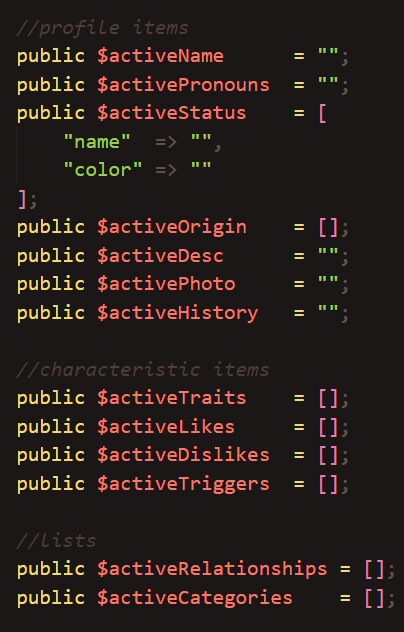
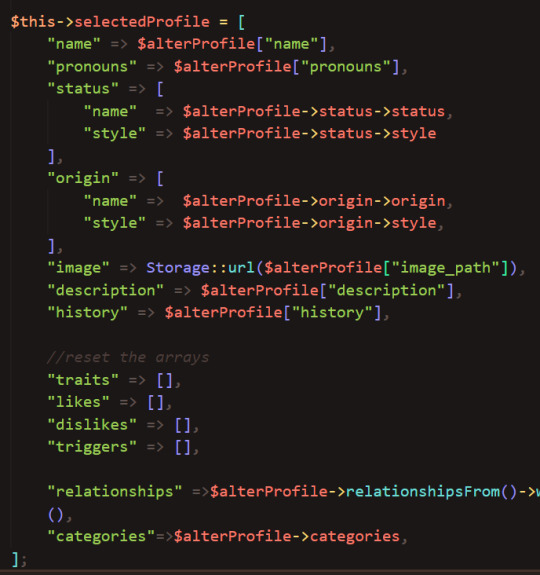
Design of the New Profile form
To be honest, I've been dreading this part since the beginning. I mean, how do I even lay this out? 💀
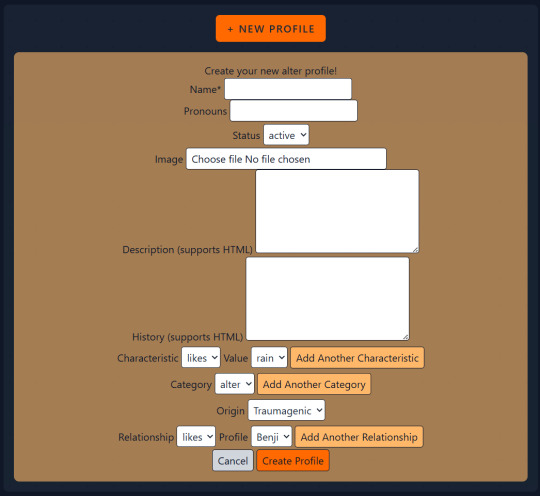
It is common for developers to avoid UI design because they are "coders not designers". I, for one, quite enjoy web design. Still, this task feels quite overwhelming to me. So, let's take this little mockup I made and turn it into something usable 💪
Too much stuff?
I think the biggest challenge here is the sheer number of inputs. And as the app grows, the number of inputs in this form will only increase.
The only mandatory input for a new profile is just their name. Therefore, the first step should be separating the Name field from the rest of the inputs.
The new and improved New Profile form is looking much better now:

...Yes, really! That's the whole form!
You are unlikely to know everything about an alter that has just split, so all those fields are completely unnecessary for an alter to be added to the list. Every other detail can be added later through the edit mode, where each field can be edited separately without needing one giant form.
Another big reason why I decided to forego the big form altogether is that the code for saving a new profile and the code for editing a profile would be almost exactly the same (including validation), and it wouldn't make sense to duplicate this code if I can just use it in one instance.
Saving a new profile
Let's add some validation to the input field to make sure that the user enters the name in a correct format.
As the Name is stored in the database as a string, it has the maximum length of 255 characters. Trying to save a longer name than this will cause errors, so we need to validate the input to make sure it's safe to insert into the database:

Here's what happens when I input a whole paragraph of Lorem Ipsum text and try to save it:

On the other hand, a shorter name saves just fine:

By the way, these flash messages are added in 2 ways: the success is a session message, and the error is an error stored separately by the validator. The flash messages originally have no styling, so I defined those myself using Tailwind's "@apply" for efficiency.
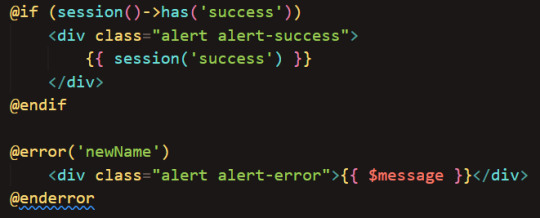
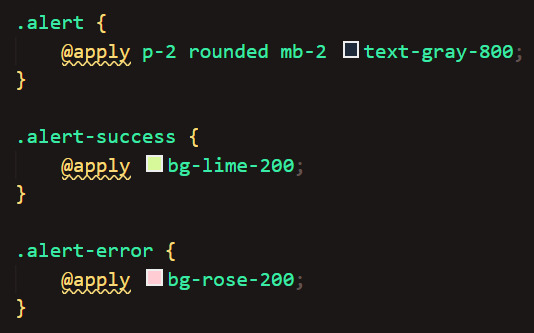
Once submitted, the name list automatically updates with our new profile:
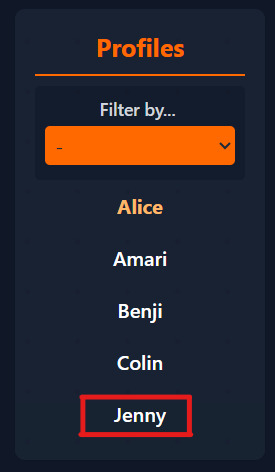
(And if I click cancel it just empties the input)

Okay, let's click on Jenny's profile to see what it looks like! ...Oh

This is because the code tries to access Jenny's status, but she doesn't have one yet, she only has a name!
(When I pull the data from the database, I'm trying to access a non-existent value)

(And when I display the values I got from the database, the display may break if the value is NULL)

(This error applies to all profile fields, not just status, however the app crashes after just the first error it comes across so the remaining errors are not shown)
This can easily fixed by using PHP's "isset()" and/or "empty()" function, which checks if a variable has a value:
(I'm using a ternary operator as a more compact alternative to if-else. it basically goes: "if this condition is true ? then do it : if not, do something else")

(And here I just check if these values are not blank before rendering them)

Success, Jenny's profile shows!
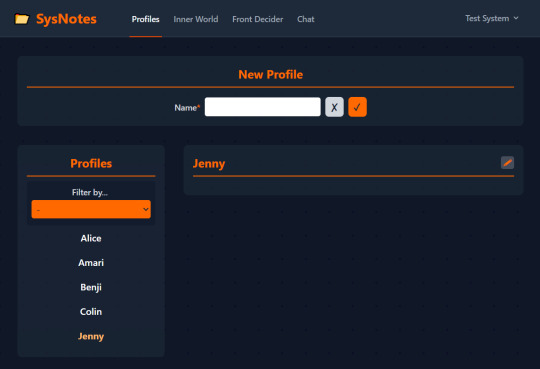
Now, we just have to populate this profile with data about Jenny, and to do that we'll need to be able to edit each field. I will work on this in the next devlog, as I expect this to take quite some time.
Thanks so reading! As always, any suggestions are welcome!
5 notes
·
View notes
Text


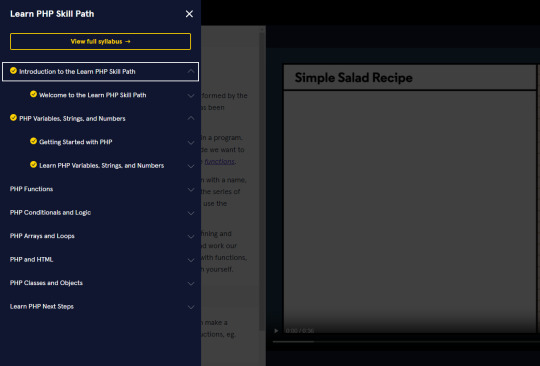
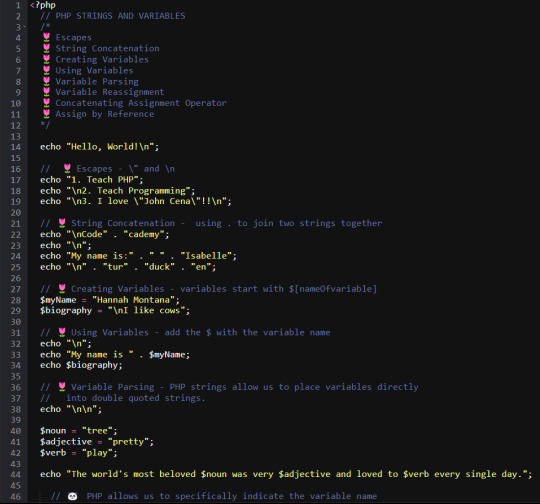
Tuesday 5th March 2024 - [ Week 1 Day 3 ]
Today I studied primarily on Codecademy's "Learn PHP Skill Path" and still on the basics but it's pretty easy??? Programming languages have a trend of starting off relatively the same, each having small differences.
I don't know if the time of this challenge I would get to the very hard parts of PHP (if there are any? I'm not sure) but so far I am loving it!
What I learnt today: 🌷 Escapes 🌷 String Concatenation 🌷 Creating Variables 🌷 Using Variables 🌷 Variable Parsing 🌷 Variable Reassignment 🌷 Concatenating Assignment Operator 🌷 Assign by Reference 🪻 Numbers 🪻 Addition and Subtraction 🪻 Using Number Variables 🪻 Multiplication and Division 🪻 Exponentiation 🪻 Order of Operations 🪻 Mathematical Assignment Operators

💌 Day 3: How do you print “Welcome to Earth!” in PHP?

[ The challenge ]

#5in5weeks#study challenge#programming#coding#studyblr#codeblr#studying#comp sci#progblr#tech#programmer#php#study#study hard#studyspiration#night study#stay productive
17 notes
·
View notes
Text
SQL Injection
perhaps, the direct association with the SQLi is:
' OR 1=1 -- -
but what does it mean?
Imagine, you have a login form with a username and a password. Of course, it has a database connected to it. When you wish a login and submit your credentials, the app sends a request to the database in order to check whether your data is correct and is it possible to let you in.
the following PHP code demonstrates a dynamic SQL query in a login from. The user and password variables from the POST request is concatenated directly into the SQL statement.
$query ="SELECT * FROM users WHERE username='" +$_POST["user"] + "' AND password= '" + $_POST["password"]$ + '";"
"In a world of locked rooms, the man with the key is king",
and there is definitely one key as a SQL statement:
' OR 1=1-- -
supplying this value inside the name parameter, the query might return more than one user.
most applications will process the first user returned, meaning that the attacker can exploit this and log in as the first user the query returned
the double-dash (--) sequence is a comment indicator in SQL and causes the rest of the query to be commented out
in SQL, a string is enclosed within either a single quote (') or a double quote ("). The single quote (') in the input is used to close the string literal.
If the attacker enters ' OR 1=1-- - in the name parameter and leaves the password blank, the query above will result in the following SQL statement:
SELECT * FROM users WHERE username = '' OR 1=1-- -' AND password = ''
executing the SQL statement above, all the users in the users table are returned -> the attacker bypasses the application's authentication mechanism and is logged in as the first user returned by the query.
The reason for using -- - instead of -- is primarily because of how MySQL handles the double-dash comment style: comment style requires the second dash to be followed by at least one whitespace or control character (such as a space, tab, newline, and so on). The safest solution for inline SQL comment is to use --<space><any character> such as -- - because if it is URL-encoded into --%20- it will still be decoded as -- -.
4 notes
·
View notes
Text
25 Udemy Paid Courses for Free with Certification (Only for Limited Time)

2023 Complete SQL Bootcamp from Zero to Hero in SQL
Become an expert in SQL by learning through concept & Hands-on coding :)
What you'll learn
Use SQL to query a database Be comfortable putting SQL on their resume Replicate real-world situations and query reports Use SQL to perform data analysis Learn to perform GROUP BY statements Model real-world data and generate reports using SQL Learn Oracle SQL by Professionally Designed Content Step by Step! Solve any SQL-related Problems by Yourself Creating Analytical Solutions! Write, Read and Analyze Any SQL Queries Easily and Learn How to Play with Data! Become a Job-Ready SQL Developer by Learning All the Skills You will Need! Write complex SQL statements to query the database and gain critical insight on data Transition from the Very Basics to a Point Where You can Effortlessly Work with Large SQL Queries Learn Advanced Querying Techniques Understand the difference between the INNER JOIN, LEFT/RIGHT OUTER JOIN, and FULL OUTER JOIN Complete SQL statements that use aggregate functions Using joins, return columns from multiple tables in the same query
Enroll Now 👇👇👇👇👇👇👇 https://www.book-somahar.com/2023/10/25-udemy-paid-courses-for-free-with.html
Python Programming Complete Beginners Course Bootcamp 2023
2023 Complete Python Bootcamp || Python Beginners to advanced || Python Master Class || Mega Course
What you'll learn
Basics in Python programming Control structures, Containers, Functions & Modules OOPS in Python How python is used in the Space Sciences Working with lists in python Working with strings in python Application of Python in Mars Rovers sent by NASA
Enroll Now 👇👇👇👇👇👇👇 https://www.book-somahar.com/2023/10/25-udemy-paid-courses-for-free-with.html
Learn PHP and MySQL for Web Application and Web Development
Unlock the Power of PHP and MySQL: Level Up Your Web Development Skills Today
What you'll learn
Use of PHP Function Use of PHP Variables Use of MySql Use of Database
Enroll Now 👇👇👇👇👇👇👇 https://www.book-somahar.com/2023/10/25-udemy-paid-courses-for-free-with.html
T-Shirt Design for Beginner to Advanced with Adobe Photoshop
Unleash Your Creativity: Master T-Shirt Design from Beginner to Advanced with Adobe Photoshop
What you'll learn
Function of Adobe Photoshop Tools of Adobe Photoshop T-Shirt Design Fundamentals T-Shirt Design Projects
Enroll Now 👇👇👇👇👇👇👇 https://www.book-somahar.com/2023/10/25-udemy-paid-courses-for-free-with.html
Complete Data Science BootCamp
Learn about Data Science, Machine Learning and Deep Learning and build 5 different projects.
What you'll learn
Learn about Libraries like Pandas and Numpy which are heavily used in Data Science. Build Impactful visualizations and charts using Matplotlib and Seaborn. Learn about Machine Learning LifeCycle and different ML algorithms and their implementation in sklearn. Learn about Deep Learning and Neural Networks with TensorFlow and Keras Build 5 complete projects based on the concepts covered in the course.
Enroll Now 👇👇👇👇👇👇👇 https://www.book-somahar.com/2023/10/25-udemy-paid-courses-for-free-with.html
Essentials User Experience Design Adobe XD UI UX Design
Learn UI Design, User Interface, User Experience design, UX design & Web Design
What you'll learn
How to become a UX designer Become a UI designer Full website design All the techniques used by UX professionals
Enroll Now 👇👇👇👇👇👇👇 https://www.book-somahar.com/2023/10/25-udemy-paid-courses-for-free-with.html
Build a Custom E-Commerce Site in React + JavaScript Basics
Build a Fully Customized E-Commerce Site with Product Categories, Shopping Cart, and Checkout Page in React.
What you'll learn
Introduction to the Document Object Model (DOM) The Foundations of JavaScript JavaScript Arithmetic Operations Working with Arrays, Functions, and Loops in JavaScript JavaScript Variables, Events, and Objects JavaScript Hands-On - Build a Photo Gallery and Background Color Changer Foundations of React How to Scaffold an Existing React Project Introduction to JSON Server Styling an E-Commerce Store in React and Building out the Shop Categories Introduction to Fetch API and React Router The concept of "Context" in React Building a Search Feature in React Validating Forms in React
Enroll Now 👇👇👇👇👇👇👇 https://www.book-somahar.com/2023/10/25-udemy-paid-courses-for-free-with.html
Complete Bootstrap & React Bootcamp with Hands-On Projects
Learn to Build Responsive, Interactive Web Apps using Bootstrap and React.
What you'll learn
Learn the Bootstrap Grid System Learn to work with Bootstrap Three Column Layouts Learn to Build Bootstrap Navigation Components Learn to Style Images using Bootstrap Build Advanced, Responsive Menus using Bootstrap Build Stunning Layouts using Bootstrap Themes Learn the Foundations of React Work with JSX, and Functional Components in React Build a Calculator in React Learn the React State Hook Debug React Projects Learn to Style React Components Build a Single and Multi-Player Connect-4 Clone with AI Learn React Lifecycle Events Learn React Conditional Rendering Build a Fully Custom E-Commerce Site in React Learn the Foundations of JSON Server Work with React Router
Enroll Now 👇👇👇👇👇👇👇 https://www.book-somahar.com/2023/10/25-udemy-paid-courses-for-free-with.html
Build an Amazon Affiliate E-Commerce Store from Scratch
Earn Passive Income by Building an Amazon Affiliate E-Commerce Store using WordPress, WooCommerce, WooZone, & Elementor
What you'll learn
Registering a Domain Name & Setting up Hosting Installing WordPress CMS on Your Hosting Account Navigating the WordPress Interface The Advantages of WordPress Securing a WordPress Installation with an SSL Certificate Installing Custom Themes for WordPress Installing WooCommerce, Elementor, & WooZone Plugins Creating an Amazon Affiliate Account Importing Products from Amazon to an E-Commerce Store using WooZone Plugin Building a Customized Shop with Menu's, Headers, Branding, & Sidebars Building WordPress Pages, such as Blogs, About Pages, and Contact Us Forms Customizing Product Pages on a WordPress Power E-Commerce Site Generating Traffic and Sales for Your Newly Published Amazon Affiliate Store
Enroll Now 👇👇👇👇👇👇👇 https://www.book-somahar.com/2023/10/25-udemy-paid-courses-for-free-with.html
The Complete Beginner Course to Optimizing ChatGPT for Work
Learn how to make the most of ChatGPT's capabilities in efficiently aiding you with your tasks.
What you'll learn
Learn how to harness ChatGPT's functionalities to efficiently assist you in various tasks, maximizing productivity and effectiveness. Delve into the captivating fusion of product development and SEO, discovering effective strategies to identify challenges, create innovative tools, and expertly Understand how ChatGPT is a technological leap, akin to the impact of iconic tools like Photoshop and Excel, and how it can revolutionize work methodologies thr Showcase your learning by creating a transformative project, optimizing your approach to work by identifying tasks that can be streamlined with artificial intel
Enroll Now 👇👇👇👇👇👇👇 https://www.book-somahar.com/2023/10/25-udemy-paid-courses-for-free-with.html
AWS, JavaScript, React | Deploy Web Apps on the Cloud
Cloud Computing | Linux Foundations | LAMP Stack | DBMS | Apache | NGINX | AWS IAM | Amazon EC2 | JavaScript | React
What you'll learn
Foundations of Cloud Computing on AWS and Linode Cloud Computing Service Models (IaaS, PaaS, SaaS) Deploying and Configuring a Virtual Instance on Linode and AWS Secure Remote Administration for Virtual Instances using SSH Working with SSH Key Pair Authentication The Foundations of Linux (Maintenance, Directory Commands, User Accounts, Filesystem) The Foundations of Web Servers (NGINX vs Apache) Foundations of Databases (SQL vs NoSQL), Database Transaction Standards (ACID vs CAP) Key Terminology for Full Stack Development and Cloud Administration Installing and Configuring LAMP Stack on Ubuntu (Linux, Apache, MariaDB, PHP) Server Security Foundations (Network vs Hosted Firewalls). Horizontal and Vertical Scaling of a virtual instance on Linode using NodeBalancers Creating Manual and Automated Server Images and Backups on Linode Understanding the Cloud Computing Phenomenon as Applicable to AWS The Characteristics of Cloud Computing as Applicable to AWS Cloud Deployment Models (Private, Community, Hybrid, VPC) Foundations of AWS (Registration, Global vs Regional Services, Billing Alerts, MFA) AWS Identity and Access Management (Mechanics, Users, Groups, Policies, Roles) Amazon Elastic Compute Cloud (EC2) - (AMIs, EC2 Users, Deployment, Elastic IP, Security Groups, Remote Admin) Foundations of the Document Object Model (DOM) Manipulating the DOM Foundations of JavaScript Coding (Variables, Objects, Functions, Loops, Arrays, Events) Foundations of ReactJS (Code Pen, JSX, Components, Props, Events, State Hook, Debugging) Intermediate React (Passing Props, Destrcuting, Styling, Key Property, AI, Conditional Rendering, Deployment) Building a Fully Customized E-Commerce Site in React Intermediate React Concepts (JSON Server, Fetch API, React Router, Styled Components, Refactoring, UseContext Hook, UseReducer, Form Validation)
Enroll Now 👇👇👇👇👇👇👇 https://www.book-somahar.com/2023/10/25-udemy-paid-courses-for-free-with.html
Run Multiple Sites on a Cloud Server: AWS & Digital Ocean
Server Deployment | Apache Configuration | MySQL | PHP | Virtual Hosts | NS Records | DNS | AWS Foundations | EC2
What you'll learn
A solid understanding of the fundamentals of remote server deployment and configuration, including network configuration and security. The ability to install and configure the LAMP stack, including the Apache web server, MySQL database server, and PHP scripting language. Expertise in hosting multiple domains on one virtual server, including setting up virtual hosts and managing domain names. Proficiency in virtual host file configuration, including creating and configuring virtual host files and understanding various directives and parameters. Mastery in DNS zone file configuration, including creating and managing DNS zone files and understanding various record types and their uses. A thorough understanding of AWS foundations, including the AWS global infrastructure, key AWS services, and features. A deep understanding of Amazon Elastic Compute Cloud (EC2) foundations, including creating and managing instances, configuring security groups, and networking. The ability to troubleshoot common issues related to remote server deployment, LAMP stack installation and configuration, virtual host file configuration, and D An understanding of best practices for remote server deployment and configuration, including security considerations and optimization for performance. Practical experience in working with remote servers and cloud-based solutions through hands-on labs and exercises. The ability to apply the knowledge gained from the course to real-world scenarios and challenges faced in the field of web hosting and cloud computing. A competitive edge in the job market, with the ability to pursue career opportunities in web hosting and cloud computing.
Enroll Now 👇👇👇👇👇👇👇 https://www.book-somahar.com/2023/10/25-udemy-paid-courses-for-free-with.html
Cloud-Powered Web App Development with AWS and PHP
AWS Foundations | IAM | Amazon EC2 | Load Balancing | Auto-Scaling Groups | Route 53 | PHP | MySQL | App Deployment
What you'll learn
Understanding of cloud computing and Amazon Web Services (AWS) Proficiency in creating and configuring AWS accounts and environments Knowledge of AWS pricing and billing models Mastery of Identity and Access Management (IAM) policies and permissions Ability to launch and configure Elastic Compute Cloud (EC2) instances Familiarity with security groups, key pairs, and Elastic IP addresses Competency in using AWS storage services, such as Elastic Block Store (EBS) and Simple Storage Service (S3) Expertise in creating and using Elastic Load Balancers (ELB) and Auto Scaling Groups (ASG) for load balancing and scaling web applications Knowledge of DNS management using Route 53 Proficiency in PHP programming language fundamentals Ability to interact with databases using PHP and execute SQL queries Understanding of PHP security best practices, including SQL injection prevention and user authentication Ability to design and implement a database schema for a web application Mastery of PHP scripting to interact with a database and implement user authentication using sessions and cookies Competency in creating a simple blog interface using HTML and CSS and protecting the blog content using PHP authentication. Students will gain practical experience in creating and deploying a member-only blog with user authentication using PHP and MySQL on AWS.
Enroll Now 👇👇👇👇👇👇👇 https://www.book-somahar.com/2023/10/25-udemy-paid-courses-for-free-with.html
CSS, Bootstrap, JavaScript And PHP Stack Complete Course
CSS, Bootstrap And JavaScript And PHP Complete Frontend and Backend Course
What you'll learn
Introduction to Frontend and Backend technologies Introduction to CSS, Bootstrap And JavaScript concepts, PHP Programming Language Practically Getting Started With CSS Styles, CSS 2D Transform, CSS 3D Transform Bootstrap Crash course with bootstrap concepts Bootstrap Grid system,Forms, Badges And Alerts Getting Started With Javascript Variables,Values and Data Types, Operators and Operands Write JavaScript scripts and Gain knowledge in regard to general javaScript programming concepts PHP Section Introduction to PHP, Various Operator types , PHP Arrays, PHP Conditional statements Getting Started with PHP Function Statements And PHP Decision Making PHP 7 concepts PHP CSPRNG And PHP Scalar Declaration
Enroll Now 👇👇👇👇👇👇👇 https://www.book-somahar.com/2023/10/25-udemy-paid-courses-for-free-with.html
Learn HTML - For Beginners
Lean how to create web pages using HTML
What you'll learn
How to Code in HTML Structure of an HTML Page Text Formatting in HTML Embedding Videos Creating Links Anchor Tags Tables & Nested Tables Building Forms Embedding Iframes Inserting Images
Enroll Now 👇👇👇👇👇👇👇 https://www.book-somahar.com/2023/10/25-udemy-paid-courses-for-free-with.html
Learn Bootstrap - For Beginners
Learn to create mobile-responsive web pages using Bootstrap
What you'll learn
Bootstrap Page Structure Bootstrap Grid System Bootstrap Layouts Bootstrap Typography Styling Images Bootstrap Tables, Buttons, Badges, & Progress Bars Bootstrap Pagination Bootstrap Panels Bootstrap Menus & Navigation Bars Bootstrap Carousel & Modals Bootstrap Scrollspy Bootstrap Themes
Enroll Now 👇👇👇👇👇👇👇 https://www.book-somahar.com/2023/10/25-udemy-paid-courses-for-free-with.html
JavaScript, Bootstrap, & PHP - Certification for Beginners
A Comprehensive Guide for Beginners interested in learning JavaScript, Bootstrap, & PHP
What you'll learn
Master Client-Side and Server-Side Interactivity using JavaScript, Bootstrap, & PHP Learn to create mobile responsive webpages using Bootstrap Learn to create client and server-side validated input forms Learn to interact with a MySQL Database using PHP
Enroll Now 👇👇👇👇👇👇👇 https://www.book-somahar.com/2023/10/25-udemy-paid-courses-for-free-with.html
Linode: Build and Deploy Responsive Websites on the Cloud
Cloud Computing | IaaS | Linux Foundations | Apache + DBMS | LAMP Stack | Server Security | Backups | HTML | CSS
What you'll learn
Understand the fundamental concepts and benefits of Cloud Computing and its service models. Learn how to create, configure, and manage virtual servers in the cloud using Linode. Understand the basic concepts of Linux operating system, including file system structure, command-line interface, and basic Linux commands. Learn how to manage users and permissions, configure network settings, and use package managers in Linux. Learn about the basic concepts of web servers, including Apache and Nginx, and databases such as MySQL and MariaDB. Learn how to install and configure web servers and databases on Linux servers. Learn how to install and configure LAMP stack to set up a web server and database for hosting dynamic websites and web applications. Understand server security concepts such as firewalls, access control, and SSL certificates. Learn how to secure servers using firewalls, manage user access, and configure SSL certificates for secure communication. Learn how to scale servers to handle increasing traffic and load. Learn about load balancing, clustering, and auto-scaling techniques. Learn how to create and manage server images. Understand the basic structure and syntax of HTML, including tags, attributes, and elements. Understand how to apply CSS styles to HTML elements, create layouts, and use CSS frameworks.
Enroll Now 👇👇👇👇👇👇👇 https://www.book-somahar.com/2023/10/25-udemy-paid-courses-for-free-with.html
PHP & MySQL - Certification Course for Beginners
Learn to Build Database Driven Web Applications using PHP & MySQL
What you'll learn
PHP Variables, Syntax, Variable Scope, Keywords Echo vs. Print and Data Output PHP Strings, Constants, Operators PHP Conditional Statements PHP Elseif, Switch, Statements PHP Loops - While, For PHP Functions PHP Arrays, Multidimensional Arrays, Sorting Arrays Working with Forms - Post vs. Get PHP Server Side - Form Validation Creating MySQL Databases Database Administration with PhpMyAdmin Administering Database Users, and Defining User Roles SQL Statements - Select, Where, And, Or, Insert, Get Last ID MySQL Prepared Statements and Multiple Record Insertion PHP Isset MySQL - Updating Records
Enroll Now 👇👇👇👇👇👇👇 https://www.book-somahar.com/2023/10/25-udemy-paid-courses-for-free-with.html
Linode: Deploy Scalable React Web Apps on the Cloud
Cloud Computing | IaaS | Server Configuration | Linux Foundations | Database Servers | LAMP Stack | Server Security
What you'll learn
Introduction to Cloud Computing Cloud Computing Service Models (IaaS, PaaS, SaaS) Cloud Server Deployment and Configuration (TFA, SSH) Linux Foundations (File System, Commands, User Accounts) Web Server Foundations (NGINX vs Apache, SQL vs NoSQL, Key Terms) LAMP Stack Installation and Configuration (Linux, Apache, MariaDB, PHP) Server Security (Software & Hardware Firewall Configuration) Server Scaling (Vertical vs Horizontal Scaling, IP Swaps, Load Balancers) React Foundations (Setup) Building a Calculator in React (Code Pen, JSX, Components, Props, Events, State Hook) Building a Connect-4 Clone in React (Passing Arguments, Styling, Callbacks, Key Property) Building an E-Commerce Site in React (JSON Server, Fetch API, Refactoring)
Enroll Now 👇👇👇👇👇👇👇 https://www.book-somahar.com/2023/10/25-udemy-paid-courses-for-free-with.html
Internet and Web Development Fundamentals
Learn how the Internet Works and Setup a Testing & Production Web Server
What you'll learn
How the Internet Works Internet Protocols (HTTP, HTTPS, SMTP) The Web Development Process Planning a Web Application Types of Web Hosting (Shared, Dedicated, VPS, Cloud) Domain Name Registration and Administration Nameserver Configuration Deploying a Testing Server using WAMP & MAMP Deploying a Production Server on Linode, Digital Ocean, or AWS Executing Server Commands through a Command Console Server Configuration on Ubuntu Remote Desktop Connection and VNC SSH Server Authentication FTP Client Installation FTP Uploading
Enroll Now 👇👇👇👇👇👇👇 https://www.book-somahar.com/2023/10/25-udemy-paid-courses-for-free-with.html
Linode: Web Server and Database Foundations
Cloud Computing | Instance Deployment and Config | Apache | NGINX | Database Management Systems (DBMS)
What you'll learn
Introduction to Cloud Computing (Cloud Service Models) Navigating the Linode Cloud Interface Remote Administration using PuTTY, Terminal, SSH Foundations of Web Servers (Apache vs. NGINX) SQL vs NoSQL Databases Database Transaction Standards (ACID vs. CAP Theorem) Key Terms relevant to Cloud Computing, Web Servers, and Database Systems
Enroll Now 👇👇👇👇👇👇👇 https://www.book-somahar.com/2023/10/25-udemy-paid-courses-for-free-with.html
Java Training Complete Course 2022
Learn Java Programming language with Java Complete Training Course 2022 for Beginners
What you'll learn
You will learn how to write a complete Java program that takes user input, processes and outputs the results You will learn OOPS concepts in Java You will learn java concepts such as console output, Java Variables and Data Types, Java Operators And more You will be able to use Java for Selenium in testing and development
Enroll Now 👇👇👇👇👇👇👇 https://www.book-somahar.com/2023/10/25-udemy-paid-courses-for-free-with.html
Learn To Create AI Assistant (JARVIS) With Python
How To Create AI Assistant (JARVIS) With Python Like the One from Marvel's Iron Man Movie
What you'll learn
how to create an personalized artificial intelligence assistant how to create JARVIS AI how to create ai assistant
Enroll Now 👇👇👇👇👇👇👇 https://www.book-somahar.com/2023/10/25-udemy-paid-courses-for-free-with.html
Keyword Research, Free Backlinks, Improve SEO -Long Tail Pro
LongTailPro is the keyword research service we at Coursenvy use for ALL our clients! In this course, find SEO keywords,
What you'll learn
Learn everything Long Tail Pro has to offer from A to Z! Optimize keywords in your page/post titles, meta descriptions, social media bios, article content, and more! Create content that caters to the NEW Search Engine Algorithms and find endless keywords to rank for in ALL the search engines! Learn how to use ALL of the top-rated Keyword Research software online! Master analyzing your COMPETITIONS Keywords! Get High-Quality Backlinks that will ACTUALLY Help your Page Rank!
Enroll Now 👇👇👇👇👇👇👇 https://www.book-somahar.com/2023/10/25-udemy-paid-courses-for-free-with.html
#udemy#free course#paid course for free#design#development#ux ui#xd#figma#web development#python#javascript#php#java#cloud
2 notes
·
View notes
Text
Complete PHP Tutorial: Learn PHP from Scratch in 7 Days
Are you looking to learn backend web development and build dynamic websites with real functionality? You’re in the right place. Welcome to the Complete PHP Tutorial: Learn PHP from Scratch in 7 Days — a practical, beginner-friendly guide designed to help you master the fundamentals of PHP in just one week.
PHP, or Hypertext Preprocessor, is one of the most widely used server-side scripting languages on the web. It powers everything from small blogs to large-scale websites like Facebook and WordPress. Learning PHP opens up the door to back-end development, content management systems, and full-stack programming. Whether you're a complete beginner or have some experience with HTML/CSS, this tutorial is structured to help you learn PHP step by step with real-world examples.
Why Learn PHP?
Before diving into the tutorial, let’s understand why PHP is still relevant and worth learning in 2025:
Beginner-friendly: Easy syntax and wide support.
Open-source: Free to use with strong community support.
Cross-platform: Runs on Windows, macOS, Linux, and integrates with most servers.
Database integration: Works seamlessly with MySQL and other databases.
In-demand: Still heavily used in CMS platforms like WordPress, Joomla, and Drupal.
If you want to build contact forms, login systems, e-commerce platforms, or data-driven applications, PHP is a great place to start.
Day-by-Day Breakdown: Learn PHP from Scratch in 7 Days
Day 1: Introduction to PHP & Setup
Start by setting up your environment:
Install XAMPP or MAMP to create a local server.
Create your first .php file.
Learn how to embed PHP inside HTML.
Example:
<?php echo "Hello, PHP!"; ?>
What you’ll learn:
How PHP works on the server
Running PHP in your browser
Basic syntax and echo statement
Day 2: Variables, Data Types & Constants
Dive into PHP variables and data types:
$name = "John"; $age = 25; $is_student = true;
Key concepts:
Variable declaration and naming
Data types: String, Integer, Float, Boolean, Array
Constants and predefined variables ($_SERVER, $_GET, $_POST)
Day 3: Operators, Conditions & Control Flow
Learn how to make decisions in PHP:
if ($age > 18) { echo "You are an adult."; } else { echo "You are underage."; }
Topics covered:
Arithmetic, comparison, and logical operators
If-else, switch-case
Nesting conditions and best practices
Day 4: Loops and Arrays
Understand loops to perform repetitive tasks:
$fruits = ["Apple", "Banana", "Cherry"]; foreach ($fruits as $fruit) { echo $fruit. "<br>"; }
Learn about:
for, while, do...while, and foreach loops
Arrays: indexed, associative, and multidimensional
Array functions (count(), array_push(), etc.)
Day 5: Functions & Form Handling
Start writing reusable code and learn how to process user input from forms:
function greet($name) { return "Hello, $name!"; }
Skills you gain:
Defining and calling functions
Passing parameters and returning values
Handling HTML form data with $_POST and $_GET
Form validation and basic security tips
Day 6: Working with Files & Sessions
Build applications that remember users and work with files:
session_start(); $_SESSION["username"] = "admin";
Topics included:
File handling (fopen, fwrite, fread, etc.)
Reading and writing text files
Sessions and cookies
Login system basics using session variables
Day 7: PHP & MySQL – Database Connectivity
On the final day, you’ll connect PHP to a database and build a mini CRUD app:
$conn = new mysqli("localhost", "root", "", "mydatabase");
Learn how to:
Connect PHP to a MySQL database
Create and execute SQL queries
Insert, read, update, and delete (CRUD operations)
Display database data in HTML tables
Bonus Tips for Mastering PHP
Practice by building mini-projects (login form, guest book, blog)
Read official documentation at php.net
Use tools like phpMyAdmin to manage databases visually
Try MVC frameworks like Laravel or CodeIgniter once you're confident with core PHP
What You’ll Be Able to Build After This PHP Tutorial
After following this 7-day PHP tutorial, you’ll be able to:
Create dynamic web pages
Handle form submissions
Work with databases
Manage sessions and users
Understand the logic behind content management systems (CMS)
This gives you the foundation to become a full-stack developer, or even specialize in backend development using PHP and MySQL.
Final Thoughts
Learning PHP doesn’t have to be difficult or time-consuming. With the Complete PHP Tutorial: Learn PHP from Scratch in 7 Days, you’re taking a focused, structured path toward web development success. You’ll learn all the core concepts through clear explanations and hands-on examples that prepare you for real-world projects.
Whether you’re a student, freelancer, or aspiring developer, PHP remains a powerful and valuable skill to add to your web development toolkit.
So open up your code editor, start typing your first <?php ... ?> block, and begin your journey to building dynamic, powerful web applications — one day at a time.

0 notes
Text
PHP $ and $$ Variables
Understanding PHP $ Sign
The PHP parser uses the dollar sign, a reserved symbol, to figure out what you've specified as a compile-time variable. Certain words and symbols have been set aside in PHP so that the parser may analyse the code script and identify code blocks by establishing explicit rules. These guidelines, or reserved names, are a means of preventing naming conflicts between your classes, variables, and fundamental PHP functions, among other things. PHP separates itself from the rest of the string (script) using the dollar sign in its syntax. Symbols (Sigil's) were employed to display variables and their scope, drawing influence from Perl, which PHP shared many characteristics with in its early days.

0 notes
Text
Große Datenmengen performant aus FileMaker übertragen und anzeigen – ohne Wartezeit
In FileMaker große Datenmengen zu verarbeiten, kann schnell zu Performance-Problemen führen. Besonders wenn FileMaker noch im Hintergrund sortiert oder aggregiert, kann die Benutzeroberfläche einfrieren oder es dauert mehrere Sekunden, bis die Daten sichtbar sind. Das Problem stellt sich immer wieder bei Altlösungen die 10 oder 20 Jahre alt sind. Häufig sind diese Datenbanken bis ins kleinste an die Kunden-Prozesse angepasst. Ein Neubau unrealistisch bis unbezahlbar. Performance-Probleme nur in den langen Listenansichten mit Unmengen an Datensätzen, diese dann noch mit Sortierungen und Formelfeldern. Doch es gibt eine Möglichkeit, Daten sofort anzuzeigen, auch wenn FileMaker noch weiterarbeitet: Daten per POST an einen WebViewer übergeben und dort asynchron anzeigen. Warum nicht einfach FileMaker-Listen? Standardmäßig lädt FileMaker Listenansichten synchron – das heißt, es wartet, bis alle Datensätze verarbeitet sind. Das führt zu Problemen, wenn: • Tausende Datensätze geladen werden, • FileMaker noch sortiert, • eine Suche viele Treffer hat, • Zusatzinformationen aus mehreren Tabellen geladen werden müssen. Die Lösung: Daten mit -X POST effizient an eine externe Webanwendung übergeben und dort direkt rendern – unabhängig davon, ob FileMaker noch weiter rechnet. Datenübergabe aus FileMaker: So geht’s richtig Wir nutzen den Insert from URL-Befehl, um die Daten per POST an eine Webanwendung zu übergeben. Hierbei setzen wir auf application/x-www-form-urlencoded, da diese Methode stabil mit großen Datenmengen arbeitet.
Set Variable [ $url ; Value: "http://meinserver.de/daten.php" ] Set Variable [ $payload ; Value: "projects=" & $id_projects & "&staff=" & $id_staff & "&anlage=" & $anlage & "&status=" & $status & "&task=" & $id_task & "&image=" & $image & "&inhalt=" & $inhalt & "&historyColors=" & $historyColors & "&planungsmonat=" & $planungsmonat & "&date_von=" & $date_von & "&date_bis=" & $date_bis & "&zeit_von=" & $zeit_von & "&zeit_bis=" & $zeit_bis & "&anzahl_staff=" & $anzahl_staff & "&staff2=" & $id_staff_2 & "&staff3=" & $id_staff_3 & "&erstellt=" & $erstellt & "&prio=" & $prio & "¬es=" & $notes ] Insert from URL [ $url ; "-X POST " & "--header \"Content-Type: application/x-www-form-urlencoded\" " & "--data " & Zitat ( $payload ) ]
Der Vorteil, ich kann unabhängig von URL-Begrenzungen Daten übergeben, ich erspare mir den Aufbau komplexer JSON-Strukturen innerhalb von FileMaker. Datentrennung geschieht bei mir vorzugsweise mit einem Pipe. Es ist natürlich auch anderes möglich. Datensammlung innerhalb von FileMaker über Schleifen, das verspricht bessere Kontrolle oder wenn es mal schnell gehen soll, geht natürlich auch die List-Funktion. Das ist aber Geschmacksache. Unser PHP-Script empfängt die Daten und kann mit der Verarbeitung beginnen. Sobald die Daten per `POST` an PHP gesendet wurden, werden sie in einzelne Arrays zerlegt, sodass sie flexibel weiterverarbeitet werden können. Durch das entdecken von Strings anhand eines Trennzeichens (z. B. `|`) lassen sich in einer einzigen Anfrage übertragen:
$projects = isset($_POST['projects']) ? explode('|', $_POST['projects']) : []; $staff = isset($_POST['staff']) ? explode('|', $_POST['staff']) : []; $anlage = isset($_POST['anlage']) ? explode('|', $_POST['anlage']) : []; $status = isset($_POST['status']) ? explode('|', $_POST['status']) : []; $task = isset($_POST['task']) ? explode('|', $_POST['task']) : []; $image = isset($_POST['image']) ? explode('|', $_POST['image']) : []; $inhalt = isset($_POST['inhalt']) ? explode('|', $_POST['inhalt']) : []; $planungsmonat = isset($_POST['planungsmonat']) ? explode('|', $_POST['planungsmonat']) : [];
Die Daten aus PHP werden dann über eine Schleife in HTML überführt. In diesem Beispiel erzeugen wir eine dynamische Tabelle, die aus den übergebenen Daten generiert wird:
<table border="1"> <tr> <th>Projekt</th> <th>Aufgabe</th> <th>Mitarbeiter</th> <th>Status</th> </tr> <?php foreach ($task as $index => $taskName): ?> <tr> <td><?= htmlspecialchars($projects[$index] ?? 'Unbekannt') ?></td> <td><?= htmlspecialchars($taskName) ?></td> <td><?= htmlspecialchars($staff[$index] ?? 'Kein Mitarbeiter') ?></td> <td><?= htmlspecialchars($status[$index] ?? 'Unbekannt') ?></td> </tr> <?php endforeach; ?> </table>
Mit ein wenig CSS kann die Liste angepasst werden, Zwischesortierungen, Statusfarben, nichts was nicht möglich ist. .task-list { width: calc(100% - 20px); /* Verhindert das Überlaufen nach rechts */ max-width: 100%; margin: 10px auto; background: white; padding: 10px; border-radius: 5px; box-shadow: 0px 0px 5px rgba(0, 0, 0, 0.2); font-size: 14px; overflow-x: hidden; /* Falls nötig, um Überlauf zu vermeiden */ } .task-group { margin-top: 15px; padding: 8px; background: #3773B5; font-size: 14px; font-weight: bold; color: white; border-radius: 5px; text-align: left; } .task-item { width: 98%; /* Damit es nicht über den Container hinausragt */ max-width: 100%; display: flex; align-items: center; justify-content: space-between; padding: 5px 10px; border-radius: 3px; box-shadow: 1px 1px 3px rgba(0, 0, 0, 0.1); font-size: 13px; line-height: 1.2; background-color: white; flex-wrap: wrap; box-sizing: border-box; /* Sorgt dafür, dass Padding berücksichtigt wird */ } Eine sequentielle Suche, die in ihrer Schnelligkeit niemals in FileMaker abzubilden ist, runden die Tabelle ab.
<script> document.getElementById("taskSearch").addEventListener("keyup", function() { let searchQuery = this.value.toLowerCase(); let taskGroups = document.querySelectorAll(".task-group-container"); let resultCount = 0; // Zähler für die Anzahl der gefundenen Datensätze taskGroups.forEach(group => { let hasMatch = false; let tasks = group.querySelectorAll(".task-item"); tasks.forEach(task => { let text = task.innerText.toLowerCase(); // Gesamten Inhalt durchsuchen if (text.includes(searchQuery)) { task.style.display = ""; // Zeigen hasMatch = true; resultCount++; // Treffer zählen } else { task.style.display = "none"; // Verstecken } }); // Gruppe ausblenden, wenn keine Aufgabe übrig ist group.style.display = hasMatch ? "" : "none"; }); // Anzeige der Trefferanzahl aktualisieren document.getElementById("searchResultsCount").textContent = resultCount + " Ergebnisse gefunden"; }); </script>
Natürlich darf die Möglichkeit aus dem WebViewer heraus mit FileMaker zu kommunizieren nicht fehlen. In diesem Fall noch mit einer Bedingung.
document.addEventListener("DOMContentLoaded", function () { document.querySelectorAll(".status-dropdown").forEach(function (dropdown) { dropdown.addEventListener("change", function () { let taskId = this.getAttribute("data-task-id"); let newStatus = this.value; if (newStatus === "Angebot folgt") { // PopOver anzeigen let modal = document.getElementById("offerModal"); modal.style.display = "flex"; // Speichern-Button im PopOver document.getElementById("confirmOffer").onclick = function () { let priority = document.getElementById("offerPriority").value; let note = document.getElementById("offerNote").value.trim(); if (note === "") { alert(" Bitte eine Notiz eingeben!"); return; } modal.style.display = "none"; // Fenster schließen // FileMaker-Skript aufrufen mit Priorität & Notiz let fileMakerScriptURL = "fmp://$/AVAGmbH?script=UpdateTaskStatus¶m=" + encodeURIComponent(taskId + "|" + newStatus + "|" + priority + "|" + note); console.log(" FileMaker-Skript aufrufen:", fileMakerScriptURL); window.location = fileMakerScriptURL; }; // Abbrechen-Button im PopOver document.getElementById("cancelOffer").onclick = function () { modal.style.display = "none"; // Fenster schließen dropdown.value = "In Planung"; // Status zurücksetzen }; return; // Stoppe die normale Ausführung, solange PopOver offen ist } // Falls NICHT "Angebot folgt", normales Verhalten let fileMakerScriptURL = "fmp://$/AVAGmbH?script=UpdateTaskStatus¶m=" + encodeURIComponent(taskId + "|" + newStatus); console.log("FileMaker-Skript aufrufen:", fileMakerScriptURL); window.location = fileMakerScriptURL; // Seite nach kurzer Verzögerung aktualisieren setTimeout(function () { window.location.reload(); }, 1000); }); }); });
Es gibt unendliche Optimierungsmöglichkeiten. Das wichtigste ist aber, wir können mit recht wenig Aufwand, alte schwergewichtige FileMaker-Anwendungen wieder flott machen.
0 notes
Text
Build Portfolio Website in Laravel 11: Your Comprehensive Guide
Building a portfolio website is an essential step for showcasing your skills, projects, and achievements in today's competitive world. Laravel 11, the latest version of the robust PHP framework, offers unparalleled tools and features to create a stunning and functional portfolio website. In this guide, we’ll walk you through the process of building a portfolio website in Laravel 11, ensuring you have a step-by-step roadmap to success.
Why Choose Laravel 11 for Your Portfolio Website?
1. Modern Features
Laravel 11 introduces enhanced routing, improved performance, and advanced tooling that make it the go-to choice for web development.
2. Scalability
Whether you're a freelancer or a business owner, Laravel 11's scalability ensures your website can grow as your portfolio expands.
3. Security
With built-in authentication and security features, Laravel 11 protects your data and provides peace of mind.
4. Community Support
Laravel’s vast community ensures you’ll find solutions to problems, tutorials, and plugins to enhance your website.
Key Features of a Portfolio Website
To build a portfolio website in Laravel 11, ensure it includes:
Homepage: A welcoming introduction.
About Section: Your background and expertise.
Projects: A gallery showcasing your work.
Contact Form: Easy communication.
Blog Section: Share insights and updates.
Responsive Design: Optimized for all devices.
Getting Started with Laravel 11
Step 1: Install Laravel 11
Start by setting up Laravel 11 on your local environment.
composer create-project --prefer-dist laravel/laravel portfolio-website
Step 2: Configure Your Environment
Update your .env file to set up the database and other environment variables.
DB_CONNECTION=mysql
DB_HOST=127.0.0.1
DB_PORT=3306
DB_DATABASE=portfolio
DB_USERNAME=root
DB_PASSWORD=yourpassword
Step 3: Set Up Authentication
Laravel 11 offers seamless authentication features.
php artisan make:auth
This command generates routes, controllers, and views for user authentication.
Step 4: Design Your Database
Create tables for your portfolio items, such as projects, blogs, and user profiles. Use migrations to structure your database.
php artisan make:migration create_projects_table
In the migration file:
Schema::create('projects', function (Blueprint $table) {
$table->id();
$table->string('title');
$table->text('description');
$table->string('image')->nullable();
$table->timestamps();
});
Run the migration:
php artisan migrate
Building the Frontend
Step 1: Choose a CSS Framework
Laravel integrates well with frameworks like Tailwind CSS and Bootstrap. Install Tailwind CSS for modern and responsive designs:
npm install -D tailwindcss
npx tailwindcss init
Configure your Tailwind file and integrate it into your project.
Step 2: Create Blade Templates
Laravel’s Blade templating engine simplifies building dynamic pages. Create a layout file in resources/views/layouts/app.blade.php:
<!DOCTYPE html>
<html>
<head>
<title>@yield('title')</title>
<link rel="stylesheet" href="{{ asset('css/app.css') }}">
</head>
<body>
<div class="container">
@yield('content')
</div>
</body>
</html>
Use this layout in other views:
@extends('layouts.app')
@section('title', 'Home')
@section('content')
<h1>Welcome to My Portfolio</h1>
@endsection
Step 3: Dynamic Content
Fetch portfolio items from the database and display them dynamically using controllers.
public function index() {
$projects = Project::all();
return view('home', compact('projects'));
}
In your Blade template:
@foreach ($projects as $project)
<div class="project">
<h2>{{ $project->title }}</h2>
<p>{{ $project->description }}</p>
<img src="{{ $project->image }}" alt="{{ $project->title }}">
</div>
@endforeach
Advanced Features
1. Search Functionality
Add search to help visitors find specific projects or blogs.
public function search(Request $request) {
$query = $request->input('query');
$projects = Project::where('title', 'LIKE', "%{$query}%")->get();
return view('search-results', compact('projects'));
}
2. File Uploads
Enable uploading images for projects.
public function store(Request $request) {
$request->validate([
'title' => 'required',
'description' => 'required',
'image' => 'nullable|image',
]);
$imagePath = $request->file('image')->store('projects', 'public');
Project::create([
'title' => $request->title,
'description' => $request->description,
'image' => $imagePath,
]);
}
3. Integrate Analytics
Use Google Analytics or similar tools to track visitor behavior.
4. Deploying Your Website
Deploy your Laravel website using platforms like Laravel Forge, AWS, or Heroku. Ensure to optimize the performance with caching and minification.
Optimizing Your Portfolio Website for SEO
Keyword Integration: Use keywords like “Build Portfolio Website in Laravel 11” strategically in titles, meta descriptions, and content.
Fast Loading Times: Optimize images and use caching.
Responsive Design: Ensure compatibility with mobile devices.
Content Strategy: Regularly update your blog to attract organic traffic.
Conclusion
Building a portfolio website in Laravel 11 is an enriching experience that showcases your skills and work to the world. By leveraging the framework’s capabilities and integrating advanced features, you can create a website that stands out in the digital landscape. Start your journey today and make your mark with a professional portfolio website
0 notes
Text
TCCI Best Place to Learn C Programming in Ahmedabad

Do you want to learn C programming in Ahmedabad? TCCI-TRIRID Computer Coaching Institute is the ideal destination for students and professionals who want to gain in-depth knowledge and hands-on experience in C programming. With experienced instructors, a structured curriculum and a student-centered approach, TCCI provides an excellent learning environment for both beginners and advanced learners.
At TCCI, we focus on building a strong foundation in C programming by providing comprehensive training covering key concepts like data types, control structures, functions, arrays, pointers and more. Our interactive classes, real-world projects and personalized guidance ensure that you not only learn theory but also develop practical skills that will help you excel in the field of software development.
TCCI in C has the following topics:
Introduction to C, Basic Syntax, Token, Data Types and Variables, Constants, Characters, Collection Class, Operators, Loop Controls, For Loop, While Loop, Do-While Loop, Decision Making, Array, String, Function, Pointer, Structure, Union , type casting, recursion, files, command line arguments.
We provide coaching in C, C++, JAVA, Python, Project Training, PHP, SEO and many more languages. TCCI also provides relevant curriculum for school students and all types of students. So visit TCCI Coaching Institute for your higher education.
For More Information:
Call us @ +91 98256 18292
Visit us @ https://tccicomputercoaching.wordpress.com/
#TCCI computer coaching institute#Best computer training near me#C language course in Ahmedabad#Best computer classes in Bopal Ahmedabad#Best computer classes in Iskon Ambli road Ahmedabad
0 notes
Text
PHP Variables : Syntax, Types, Scope, and Best Practices
Learn all about PHP variables including syntax, data types, variable scope, and best practices. A beginner-friendly guide to mastering PHP variables with examples. PHP Variables – A Complete Guide for Beginners PHP (Hypertext Preprocessor) is a powerful server-side scripting language widely used for web development. One of the foundational concepts in PHP—and in any programming language—is…
#PHP array variable#PHP for beginners#PHP global variable#PHP local variable#PHP programming#PHP static variable#PHP string variable#PHP syntax#PHP tutorial#PHP variable example#PHP variable naming#PHP variable scope#PHP variable types#PHP variables
0 notes
Text

What Are PHP Arrays and How Do They Work?
Arrays are a crucial concept in programming, and if you’re working with PHP, mastering arrays is essential. Arrays allow you to store multiple values in a single variable, making them powerful tools for handling complex data. In this article, we’ll dive deep into PHP arrays, exploring what they are, how they work, their different types, and some best practices to optimize their usage.
Whether you're a beginner or looking to strengthen your PHP skills, understanding arrays will take you a long way in web development. And if you want to become proficient in PHP and web programming, you can always join the PHP programming course at CADL to get expert guidance and hands-on experience.
What Is an Array?
An array is a data structure that can hold more than one value at a time. Instead of creating multiple variables for storing related data, you can use an array to store all the values under a single variable name.
In PHP, an array is a type of variable that allows you to store a collection of values, and these values can be of any data type (integers, strings, or even other arrays). Each value in an array is associated with an index, which helps you access and manipulate the stored data easily.
How Do PHP Arrays Work?
PHP arrays work by associating each value with a key or index. These keys can be either numeric or associative (strings). There are three main types of arrays in PHP:
Indexed Arrays (Numeric arrays)
Associative Arrays
Multidimensional Arrays
Let’s break down each of these types in more detail.
1. Indexed Arrays
Indexed arrays are the most straightforward type of arrays in PHP. They are also known as numeric arrays because they use numerical indexes (starting from 0) to access and reference each value stored in the array.
Syntax:
You can create an indexed array using the array() function or by directly assigning values using square brackets [].
php
Copy code
// Creating an Indexed Array using array() function
$fruits = array("Apple", "Banana", "Orange");
// Creating an Indexed Array using []
$fruits = ["Apple", "Banana", "Orange"];
Accessing Values:
To access values in an indexed array, you can use the index numbers (starting from 0).
php
Copy code
echo $fruits[0]; // Output: Apple
echo $fruits[1]; // Output: Banana
Adding Values:
You can add new elements to an indexed array like this:
php
Copy code
$fruits[] = "Mango"; // Adds Mango to the array
2. Associative Arrays
Unlike indexed arrays, associative arrays use named keys (strings) instead of numerical indexes. This is useful when you need to store and retrieve data using meaningful labels instead of numbers.
Syntax:
You can create associative arrays using the array() function or by using key-value pairs within square brackets [].
php
Copy code
// Creating an Associative Array
$ages = array("John" => 28, "Jane" => 32, "Tom" => 24);
// Creating using []
$ages = ["John" => 28, "Jane" => 32, "Tom" => 24];
Accessing Values:
To access values, you use the associated key.
php
Copy code
echo $ages["John"]; // Output: 28
echo $ages["Jane"]; // Output: 32
Adding Values:
Adding a new element to an associative array is simple. Just assign a value to a new key.
php
Copy code
$ages["Alice"] = 29; // Adds Alice with age 29 to the array
Associative arrays are extremely useful for storing data where key-value relationships make sense, such as storing form data or user details.
3. Multidimensional Arrays
Multidimensional arrays are arrays that contain other arrays. They allow you to create complex data structures by nesting arrays within arrays, which is useful for representing more intricate data.
Syntax:
Here’s how you create a multidimensional array in PHP:
php
Copy code
$users = array(
array("name" => "John", "age" => 28),
array("name" => "Jane", "age" => 32),
array("name" => "Tom", "age" => 24)
);
Accessing Values:
To access values in a multidimensional array, you use multiple indexes or keys.
php
Copy code
echo $users[0]["name"]; // Output: John
echo $users[1]["age"]; // Output: 32
Adding Values:
You can add new elements by appending arrays to the existing multidimensional array.
php
Copy code
$users[] = array("name" => "Alice", "age" => 29);
Multidimensional arrays are particularly useful when dealing with databases or JSON data, where you have rows of related information.
PHP Array Functions
PHP provides a rich set of built-in functions for manipulating arrays. Here are some commonly used ones:
1. count()
This function returns the number of elements in an array.
php
Copy code
$fruits = ["Apple", "Banana", "Orange"];
echo count($fruits); // Output: 3
2. array_push()
This function adds one or more elements to the end of an array.
php
Copy code
$fruits = ["Apple", "Banana"];
array_push($fruits, "Orange", "Mango");
3. array_merge()
This function merges two or more arrays into one.
php
Copy code
$fruits1 = ["Apple", "Banana"];
$fruits2 = ["Orange", "Mango"];
$allFruits = array_merge($fruits1, $fruits2);
4. in_array()
This function checks if a value exists in an array.
php
Copy code
$fruits = ["Apple", "Banana"];
if (in_array("Apple", $fruits)) {
echo "Apple is in the array.";
}
5. array_keys()
This function returns all the keys from an array.
php
Copy code
$ages = ["John" => 28, "Jane" => 32];
$keys = array_keys($ages);
Best Practices for Working with PHP Arrays
When using arrays in PHP, keep the following tips in mind for better code organization and performance:
1. Choose the Right Type of Array
Use indexed arrays when the order matters or when you need fast access to data using numeric keys.
Use associative arrays when the relationship between keys and values is important.
Use multidimensional arrays when handling complex data structures.
2. Optimize Array Size
If you’re working with large arrays, be mindful of memory usage. Use unset() to remove elements that are no longer needed to free up memory.
3. Use PHP’s Built-in Array Functions
Instead of writing loops to manipulate arrays manually, leverage PHP’s built-in array functions like sort(), array_filter(), and array_map() to improve performance and code readability.
4. Consistent Key Naming
When using associative arrays, ensure that your keys are consistently named and formatted to avoid confusion and bugs in your code.
Why Join the PHP Programming Course at CADL?
Understanding and mastering arrays in PHP is just the beginning. To become a proficient PHP developer, it's essential to gain a deeper understanding of other PHP concepts, such as object-oriented programming, file handling, database interaction, and more.
At CADL (Chandigarh Academy of Digital Learning), we offer a comprehensive PHP Programming Course designed for both beginners and professionals. Here’s what you’ll get:
Hands-on experience with real-world projects.
Expert instructors to guide you through complex PHP concepts.
Detailed lessons on PHP arrays, functions, classes, and database integration.
A solid foundation in full-stack web development using PHP.
Whether you're looking to start your career in web development or upgrade your skills, our PHP programming course will equip you with the knowledge and tools you need to succeed. Join CADL today and take your PHP skills to the next level!
Conclusion
PHP arrays are versatile tools that allow developers to handle multiple values efficiently. By understanding the different types of arrays—indexed, associative, and multidimensional—you can write cleaner, more efficient code. Incorporating best practices and using PHP's built-in array functions will make your coding experience smoother.
Ready to dive deeper into PHP and web development? Join CADL’s PHP programming course and become a skilled developer, capable of building robust, dynamic websites from scratch!
0 notes
Text
$get and $post variables in php with syntax and examples
$get and $post variables in php with syntax and examples In PHP, $_GET and $_POST are superglobal variables used to access data sent to the server through HTTP requests. Syntax: - $_GET: $_GET['variable_name'] - $_POST: $_POST['variable_name'] Examples: 1. $_GET: Retrieves data from the URL query string. Example: // URL: (link unavailable)?name=John&age=30 echo $_GET['name']; // outputs…
0 notes
Text
From Basics to Advanced: PHP Data Types and Comments Tutorial in Hindi
youtube
Dive into the fundamentals of PHP data types and comments with our comprehensive tutorial. We'll explore PHP's various data types, including integers, floats, strings, booleans, and arrays, and teach you how to declare variables, assign values, and perform basic operations.
Learn the importance of comments in your code, enhancing readability and maintainability for better collaboration and documentation.
Whether you're a beginner or an aspiring web developer, this tutorial will provide you with the essential knowledge to become proficient in PHP web development.
0 notes
Text
Mastering PHP: The Ultimate Guide for Aspiring Expert PHP Developers

Introduction
Welcome to CompleteGurus, your go-to resource for all things tech! Today, we’re diving into the world of PHP development. Whether you’re a novice just starting out or an experienced coder looking to level up, becoming an expert PHP developer requires dedication, continuous learning, and practical experience. Let’s explore the roadmap to mastering PHP and the essential skills every expert PHP developer should have. #expertPHPdeveloper
Understanding the Basics
What is PHP?
PHP (Hypertext Preprocessor) is a widely-used, open-source scripting language designed for web development. It’s embedded in HTML and is known for its efficiency in handling dynamic content, databases, and session tracking.
Why PHP?
Ease of Use: PHP’s syntax is easy to understand and learn, making it a favorite among beginners.
Community Support: A large, active community provides extensive resources, frameworks, and libraries.
Compatibility: PHP is compatible with various servers and databases, including Apache, Nginx, MySQL, and PostgreSQL.
Performance: PHP is fast and efficient, especially when it comes to handling server-side scripting.
Building a Strong Foundation
Learning the Language
To become an expert, you must have a thorough understanding of PHP’s syntax, functions, and features. Here are some key areas to focus on:
Variables and Data Types: Understand how to declare and use different data types.
Control Structures: Master if-else statements, switch cases, loops (for, while, foreach).
Functions: Learn to create and use functions, including variable scope and anonymous functions.
Arrays and Strings: Work extensively with arrays (indexed, associative, multidimensional) and string manipulation functions.
Object-Oriented Programming (OOP)
OOP is a critical aspect of advanced PHP development. Ensure you understand the following concepts:
Classes and Objects: Learn how to define and instantiate classes.
Inheritance: Understand how child classes inherit properties and methods from parent classes.
Encapsulation: Learn to protect the state of an object using access modifiers.
Polymorphism: Understand how objects can take on many forms through interfaces and abstract classes.
Advanced PHP Development
Frameworks
To streamline development and maintain code quality, familiarize yourself with popular PHP frameworks:
Laravel: Known for its elegant syntax and powerful features, Laravel is a favorite among developers.
Symfony: Offers a robust set of reusable PHP components and a modular architecture.
CodeIgniter: Lightweight and straightforward, ideal for small to medium projects.
Working with Databases
An expert PHP developer must be proficient in database management:
SQL: Master SQL queries to interact with databases.
PDO and MySQLi: Learn to use PHP Data Objects (PDO) and MySQLi for secure and efficient database operations.
ORM: Understand Object-Relational Mapping (ORM) with tools like Eloquent in Laravel.
Security Practices
Security is paramount in web development. Ensure you follow best practices:
Data Sanitization and Validation: Always sanitize and validate user inputs.
Prepared Statements: Use prepared statements to prevent SQL injection.
Password Hashing: Securely store passwords using hashing algorithms like bcrypt.
HTTPS: Ensure secure data transmission by implementing HTTPS.
Testing and Debugging
Quality assurance is essential. Learn to:
Unit Testing: Write unit tests to ensure code reliability using PHPUnit.
Debugging: Use debugging tools and techniques to identify and fix issues.
Version Control: Use Git for version control and collaboration.
Continuous Learning and Community Engagement
Stay Updated
The tech world evolves rapidly. Stay ahead by:
Reading Blogs: Follow blogs and forums like CompleteGurus, PHP.net, and Stack Overflow.
Attending Conferences: Participate in PHP conferences and meetups.
Taking Courses: Enroll in advanced PHP courses on platforms like Udemy, Coursera, and LinkedIn Learning.
Contribute to the Community
Open Source Projects: Contribute to open-source projects to gain real-world experience.
Writing and Speaking: Share your knowledge through blogging, speaking at events, or creating tutorials.
Networking: Connect with other developers, join PHP groups, and participate in discussions.
Conclusion
Becoming an expert PHP developer is a journey that involves mastering the language, understanding advanced concepts, and continuously learning. By following this roadmap and engaging with the community, you'll hone your skills and stay at the forefront of PHP development. Ready to take the next step? Dive into the resources available here at CompleteGurus and embark on your path to becoming an #expertPHPdeveloper!
0 notes
Text
4 Udemy Paid Courses for Free with Certification (Limited Time for Enrollment)

1. 07 Days of Code | Python Programming BootCamp
Python Programming Language with Full Practical, Exercises, Assignments, Problems and their Solutions.
What you'll learn
You will learn Python within few days with practical examples, exercises, assignments, and problems with solutions.
You will learn Fundamental of Python as data types, Input / Output Operations, List, Tuples, Dictionary, SET, Decision Making, Loops, Functions etc
You will learn Python Programming with solving Real World Problems with their solution.
You will learn how to create a Python based website.
You will get Python based Quiz at the end of the Course
By the end of this 7-day course, students will have the confidence and skills to learn more advanced Python topics, such as machine learning, data science, and
By the end of this course, students will have a solid understanding of Python programming fundamentals and be able to write basic Python programs.
Take This Course
👇👇👇👇👇👇👇
4 Udemy Paid Courses for Free with Certification (Limited Time for Enrollment)
2. Java And PHP Complete Course
Learn Java Programming And PHP Programming In One Complete Course
What you'll learn
You will learn how to write a complete Java program that takes user input, processes and outputs the results
You will learn java concepts such as console output, Java Variables and Data Types, Java Operators And more
You will learn PHP concepts such as basic syntax, input and output techniques, and console IO
You will learn PHP arithmetic, assignment, conditional, comparison operators
You will learn PHP loops and conditional statements,POST and GET and more.
Take This Course
👇👇👇👇👇👇👇
4 Udemy Paid Courses for Free with Certification (Limited Time for Enrollment)
3. Learn Coding with Java from Scratch: Essential Training
Mastering Java 17 with the modern features, know how it works. Become A Professional Java Developer in no time!
What you'll learn
Introduction to coding with Java
Java Tools and Setup
Variables, Data Types, Casting, Operators, and doing Mathematics
Strings and Working with text using Java Techniques
Flow control and Making Different Decisions: if - else if - else, and switch - case
Loops, Repetitions, and Iterations: while, do while, for, and Controlling blocks
Working with Arrays in depth
Methods and functional programming in Java
Object-Oriented Programming: Classes, Objects, Attributes, Modifiers, and More
Advanced Object-Oriented Programming: Inheritance, Interfaces, Enumerations and More
Take This Course
👇👇👇👇👇👇👇
4 Udemy Paid Courses for Free with Certification (Limited Time for Enrollment)
4. Object-Oriented Programming (OOP) - Learn to Code Faster
Learn and Practice Object-Oriented Programming(OOP) with Python, Know how it works, and Learn how to code faster 2024
What you'll learn
Understand the benefit of using Object-Oriented Programming
Learn how to build programs faster in Python
Use and apply the classes and instances components and tools with many examples
How to use different types of inheritance in different scales
Learn Encapsulation for wrapping code and data together into a single unit
Learn all about Access Modifiers and Getters and Setters
How to use and apply Polymorphism in an object oriented style with many examples
Learn how to abstract a problem in OOP in action
Practice Object oriented programming, basics to advanced level, using Modern Python
Get the instructor QA support
Take This Course
👇👇👇👇👇👇👇
4 Udemy Paid Courses for Free with Certification (Limited Time for Enrollment)
0 notes